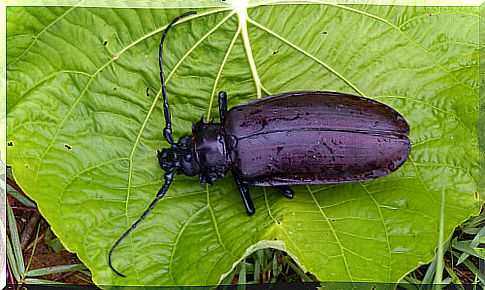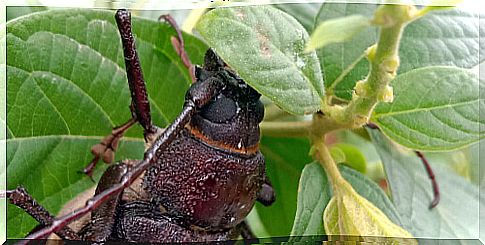All About The Amazon Titanus Giganteus

When the Titanus giganteus beetle reaches adulthood it can grow to about 6.5 inches (16.7 cm) long, hence its name, which means “giant titan.” This insect has incredibly strong jaws that can break wooden pencils in half. Fortunately, they are quite harmless to humans.
It belongs to the coleoptera, a very varied family
According to Professor Joseph V. McHugh (University of Georgia) and Professor James K. Liebherr (Cornell University), beetles comprise 25% of all animals and plants described. This makes them the main contributors to the world’s known biodiversity. The 350,000 species of beetles described are members of the largest taxonomic order of life on Earth, the Coleoptera.
Coleoptera are known by many names and include fireflies, ladybugs, weevils, and, of course, beetles. The large number of coleopteran species is reflected in a bewildering array of anatomical and biological diversity in order. Coleoptera are represented in almost all biogeographic regions and non-marine habitats.
Most adult beetles can fly. However, when not in use, the delicate flight wings are usually hidden under the protective shell-shaped elytra. The Titanus giganteus also have wings that can fly moderate distances.

Most beetles are herbivores, fungivores, or predatory carnivores throughout their life cycles. Many are considered serious pests of our homes, forests, crops and stored products, while some beneficial species are regularly used as biological control agents.
Although beetles share common characteristics, there are notable variations in appearance from their species. For example, adult body size ranges from 0.4mm long Nanosella fungi beetles to 200mm long Titanus giganteus beetles from South America.
The Titanus giganteus is a mysterious animal
The giant titan is one of the most mysterious creatures on Earth. Like the Attacus atlas , the Titanus giganteus beetle does not feed during its adult life.
Those who have studied this insect suggest that it lives underground for several years before reaching maturity. Moreover, the larvae of this incredible insect have never been found. However, judging by the large pits found in dead trees in their natural habitat, scientists believe that titan beetle larvae feed on decaying wood. Also, the size of these holes suggests that the larvae are around two inches in diameter and up to a foot long.
In its adult stage, it uses the reserves gathered in its pupal stage to fly far enough to find a mate. Because they mostly sit around waiting for the males to search for them and fertilize their eggs, the females have rarely been seen.

The Hercules beetle is considered to be the longest beetle in the world, measuring over 7 inches (over 17.5 cm) due to its huge horn. However, the Titanus giganteus is still the largest beetle in the world and also one of the largest insects on the planet.
It is curious to know that the giant titan defends itself by whistling in warning and using its large jaws to bite the attackers. It also has very strong legs, equipped with sharp claws that can literally rip through flesh. He never attacks without provocation, but must be handled with care.
He leads a very discreet life
The Titanus giganteus lives discreetly deep in the Amazon rainforest in some of the countries of South America. Specifically, in the warmer rainforests. As we already mentioned, he only ventures abroad except when he is looking for a partner.
In Colombia, Ecuador, Peru, Bolivia, the Guianas, and north-central Brazil, locals and researchers try to capture them after dark, with bright lights. This is because, at nightfall, bright lights attract these beetles.
Mercury vapor lamps, in particular, are used to attract male titan beetles in French Guiana. There is an ecotourism industry based on providing sightings and specimens of these beetles to tourists visiting villages in the region. Each beetle can cost up to five hundred US dollars.

Getting protection through collectors
Contradictory as it may seem, the value of the beetle in the collectors market is what provides the funds and awareness necessary for its conservation. Because titan beetles are so dependent on “good quality wood” for survival, not only are the beetles benefitting from conservation efforts, but the entire ecosystem that surrounds their living environment.
The females are very difficult to collect and the males are caught by locals and sold to collectors. This does not harm the general population at all, since the males are only needed to fertilize the eggs of the females.









